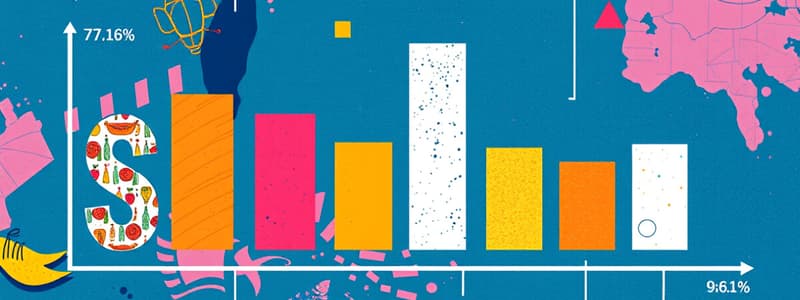Podcast
Questions and Answers
What is statistics?
What is statistics?
- A demographic analysis
- A mathematical procedure for organizing, summarizing and interpreting information (correct)
- A single observation
- A type of data
What is a population in a study?
What is a population in a study?
A set of all individuals of interest in a particular study
What is a sample?
What is a sample?
A set of individuals selected from a population
What does a variable represent?
What does a variable represent?
What are data?
What are data?
Define a data set.
Define a data set.
What is a datum?
What is a datum?
What is a parameter?
What is a parameter?
What is a statistic?
What is a statistic?
What are descriptive statistics?
What are descriptive statistics?
What are inferential statistics?
What are inferential statistics?
What is sampling error?
What is sampling error?
What does a correlational method do?
What does a correlational method do?
What is a control condition?
What is a control condition?
What is an experimental condition?
What is an experimental condition?
What is a quasi-independent variable?
What is a quasi-independent variable?
What are constructs?
What are constructs?
What is an operational definition?
What is an operational definition?
What is a discrete variable?
What is a discrete variable?
What is a continuous variable?
What is a continuous variable?
What are real limits?
What are real limits?
What is a nominal scale?
What is a nominal scale?
What is an ordinal scale?
What is an ordinal scale?
What is an interval scale?
What is an interval scale?
What is a ratio scale?
What is a ratio scale?
What is the experimental method?
What is the experimental method?
What is an independent variable?
What is an independent variable?
What is a dependent variable?
What is a dependent variable?
Flashcards
What is Statistics?
What is Statistics?
Mathematical procedures for organizing, summarizing, and interpreting information.
What is a Population?
What is a Population?
The entire group of individuals that is relevant to a study.
What is a Sample?
What is a Sample?
A subset selected from a population to represent it in research.
What is a Variable?
What is a Variable?
Signup and view all the flashcards
What is Data?
What is Data?
Signup and view all the flashcards
What is a Data set?
What is a Data set?
Signup and view all the flashcards
What is Datum?
What is Datum?
Signup and view all the flashcards
What is a Parameter?
What is a Parameter?
Signup and view all the flashcards
What is a Statistic?
What is a Statistic?
Signup and view all the flashcards
What are Descriptive Statistics?
What are Descriptive Statistics?
Signup and view all the flashcards
What are Inferential Statistics?
What are Inferential Statistics?
Signup and view all the flashcards
What is Sampling Error?
What is Sampling Error?
Signup and view all the flashcards
What is Correlational Method?
What is Correlational Method?
Signup and view all the flashcards
What is a Control Condition?
What is a Control Condition?
Signup and view all the flashcards
What is the Experimental Condition?
What is the Experimental Condition?
Signup and view all the flashcards
What is Quasi-Independent Variable?
What is Quasi-Independent Variable?
Signup and view all the flashcards
What are Constructs?
What are Constructs?
Signup and view all the flashcards
What is Operational Definition?
What is Operational Definition?
Signup and view all the flashcards
What are Discrete Variables?
What are Discrete Variables?
Signup and view all the flashcards
What are Continuous Variables?
What are Continuous Variables?
Signup and view all the flashcards
What are Real Limits?
What are Real Limits?
Signup and view all the flashcards
What is Nominal Scale?
What is Nominal Scale?
Signup and view all the flashcards
What is Ordinal Scale?
What is Ordinal Scale?
Signup and view all the flashcards
What is Interval Scale?
What is Interval Scale?
Signup and view all the flashcards
What is Ratio Scale?
What is Ratio Scale?
Signup and view all the flashcards
What is Experimental Method?
What is Experimental Method?
Signup and view all the flashcards
What is an Independent Variable?
What is an Independent Variable?
Signup and view all the flashcards
What is a Dependent Variable?
What is a Dependent Variable?
Signup and view all the flashcards
Study Notes
Statistics Fundamentals
- Statistics refers to mathematical procedures for organizing, summarizing, and interpreting information.
- A population is the complete set of all individuals relevant to a study.
- A sample is a subset chosen from a population to represent it in research.
Key Concepts in Data
- A variable is a characteristic or condition that can change across individuals.
- Data consists of collected measurements or observations.
- A data set is a collection of such measurements or observations.
- The term datum refers to a single measurement or observation, often known as a score.
Parameters and Statistics
- A parameter describes a population's numerical attributes, derived from individuals' measurements.
- A statistic represents a sample's numerical characteristics, also derived from individual measurements.
Types of Statistics
- Descriptive statistics summarize, organize, and simplify data.
- Inferential statistics enable generalizations about populations based on sample analyses.
- Sampling error indicates the difference between sample statistics and population parameters.
Research Methods
- The correlational method examines the relationship between two different variables.
- Control conditions involve individuals who do not receive the experimental treatment for comparison purposes.
- Experimental conditions involve individuals who receive the treatment being tested.
Variables in Research
- A quasi-independent variable categorizes groups in a nonexperimental setting.
- Constructs are internal characteristics or attributes used to explain behavior, though they cannot be directly observed.
Measurement and Definitions
- An operational definition describes the measurement procedures for external behaviors and defines constructs based on resultant measurements.
- Discrete variables are composed of distinct categories with no intermediate values, while continuous variables can take on an infinite number of values within a range.
Measurement Scales
- Real limits are boundaries for scores on a continuous scale, with each score having upper and lower limits.
- The nominal scale categorizes observations without quantitative distinctions.
- The ordinal scale ranks categories in a meaningful order based on size or magnitude.
- The interval scale has equal intervals between categories with an arbitrary zero point.
- The ratio scale possesses an absolute zero point, allowing for meaningful ratio comparisons between values.
Experimental Design
- The experimental method manipulates one variable to observe its impact on another, aiming to confirm cause-and-effect relationships.
- The independent variable in a study is the one controlled by the researcher, usually involving multiple treatment conditions.
- The dependent variable is the one being evaluated to determine the treatment's effect.
Studying That Suits You
Use AI to generate personalized quizzes and flashcards to suit your learning preferences.




